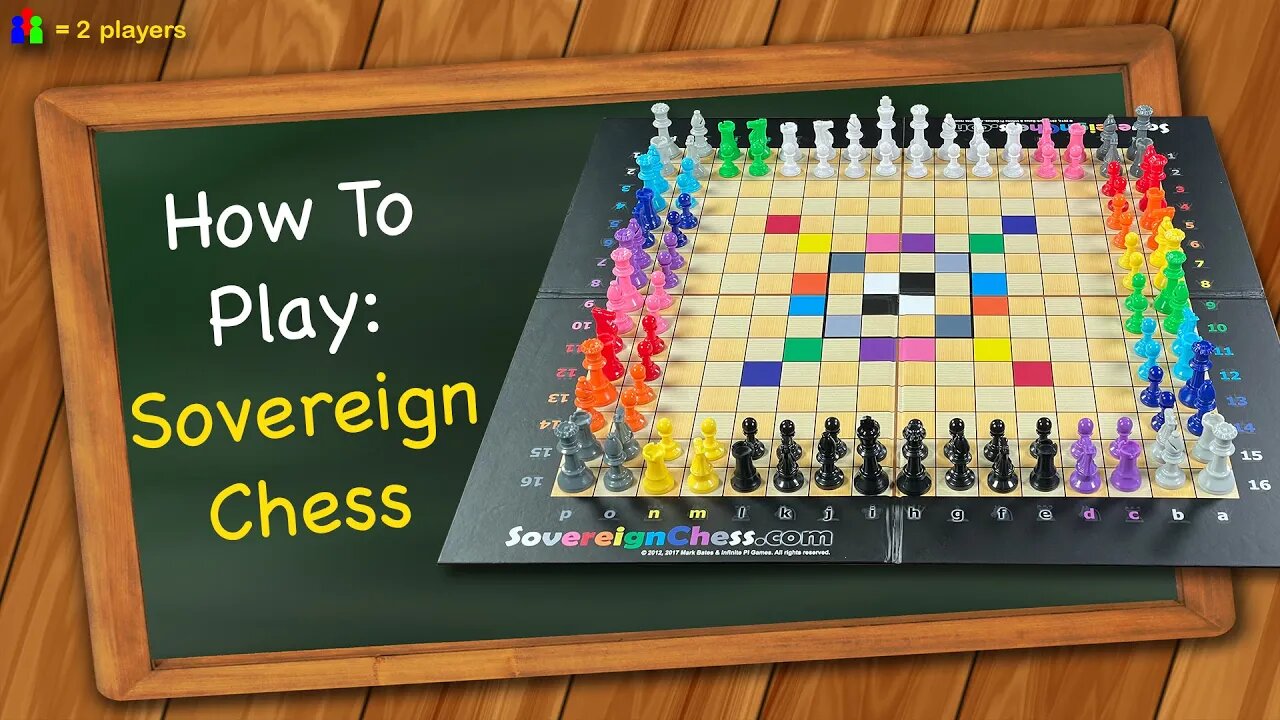Premium Only Content

How to play Sovereign Chess
Learn the rules to Sovereign Chess quickly and concisely - This video has no distractions, just the rules. For a refresher of the original Chess rules, check out this video: https://youtu.be/fKxG8KjH1Qg
Don't own the game? Buy it here: https://buy.triplesgames.com/SovereignChess
RULES:
The rules are the same as regular chess except for these changes. Lay out the board and setup the pieces on the outer ring of squares, matching each piece with the color and type indicated around the edge of the board. In the next ring of squares, place pawns matching the colors of the adjacent pieces. In the four corners, instead of pawns place matching-colored knights.
Randomly select a player to make white’s first move. After white’s first move, the other player may choose to play as white or play as black. Whoever plays black makes the next move then turns alternate. Queens, Bishops, and Rooks may not travel more than 8 squares in a single turn. Therefore, they may not check a king that is farther than 8 squares away. Kings are allowed to move out of check by moving out of this range.
A piece may not end its turn on a square of its own color, but it may travel over a square of its own color. Therefore, a player may not check their opponent’s king with a piece of the same color as the square that that king is on. Kings are allowed to escape check by moving to a square matching the color of the checking piece.
Pawns move 1 square vertically or horizontally, and capture 1 square diagonally, towards the center of the board. The brown lines on the board help guide pawns toward the center. Pawns move and capture towards either brown line, even if that move is further away from another brown line. A pawn adjacent to a brown line may not move across it, but it may capture across a brown line so long as the capture takes it closer to the center of the board.
Pawns on the outer 2 rings of the board may move 1 or 2 spaces away from the closest edge. They may move like this even if they have moved previously. En passant is not allowed.
When you move one of your pieces onto a square of another color, you then control all the pieces of that square’s color and may move them so long as you have a piece on that square. Once the colored square is unoccupied, then you may not move those pieces until you occupy one of the matching color squares again. You are allowed to use your controlled colored pieces to control other colors.
When you move a piece to a square that is the same color as your opponent’s king you do not gain control of their pieces. Pieces that are the same color as a player's king may never be controlled by their opponent.
There are two squares of each color but only one of those squares may be occupied at a time. When one square is occupied by any piece, whether a player controls it or not, then the other square of that color may not be occupied.
You may only capture pieces of colors that your opponent controls. You may not capture any piece you control, nor pieces that are uncontrolled by either player. If you capture an opponent’s piece that is on a colored square, you immediately take control of all pieces of that square’s color. You may escape check from a colored piece by capturing the matching colored square your opponent controls, giving you control of those pieces instead.
When a pawn reaches the center 4x4 area marked by a black border, it must promote to any higher piece of its same color, which may include a king. If you choose to promote a pawn to a king, you remove your current king from the board, and place the new king, of the same color of the pawn, where the pawn was promoted. [show 2 examples: Coup d’Etat & Overthrow]
If you promote to a king of a different color, then your previous king’s colored pieces will now be controlled by the player who occupies a square of that color.
On your turn, instead of moving a piece, you may replace your king with a king of any color you control. Your turn then ends unless your king is now on a square of its own color. Then you must legally move it off of that square.
You are allowed to promote to a king or change your king’s color to get out of check. There is no limit to the number of times you can change kings during the game.
You are allowed to castle with any rook you control that is on the same row as your king so long as all the normal rules of castling are followed. To do so, move your king to any vacant square between it and the rook and that rook to the other side of the king. Changing a king to a different color does not count as moving it, so you may still castle.
The first player to checkmate their opponent, wins.
-
![I'm Grand (Master) [Official Music Video] - Triple S Games & Sheet Music Boss](https://1a-1791.com/video/s8/1/9/v/q/d/9vqdo.0kob-small-Im-Grand-Master-Official-Mu.jpg) 3:36
3:36
Triple S Games
1 year ago $0.07 earnedI'm Grand (Master) [Official Music Video] - Triple S Games & Sheet Music Boss
1.92K6 -
 LIVE
LIVE
SpartakusLIVE
5 hours ago#1 Specialist EASTER EGG Champion brings YOU Friday Night HYPE
4,059 watching -

Badlands Media
11 hours agoThe Liberty Den Ep. 146
28.4K2 -
 2:36:40
2:36:40
DDayCobra
4 hours ago $0.93 earnedIsrael vs Iran Getting WORSE
28.1K9 -
 LIVE
LIVE
GamerGril
1 hour agoT.G.I. FrightDay The 13th | Who Puts The Whore In Horde
149 watching -
 LIVE
LIVE
JimmmyChaCha
2 hours agoLIVE - HALO 2 CAMPAIGN
117 watching -
 2:28:22
2:28:22
TheSaltyCracker
4 hours agoWelcome to WW3 ReeEEeeStream 06-13-25
98.7K190 -
 14:59
14:59
T-SPLY
7 hours agoKilmar Is Facing Trafficking Charges / Lawyer Demands His Release!
11.8K13 -
 2:04:42
2:04:42
TimcastIRL
4 hours agoU.S. Enters Israel Iran War In Defense Of Israel, Deaths CONFIRMED After Iran Strikes | Timcast IRL
167K269 -
 1:25:04
1:25:04
Laura Loomer
4 hours agoEP126: OPEN BORDERS INTIFADA
45.1K17